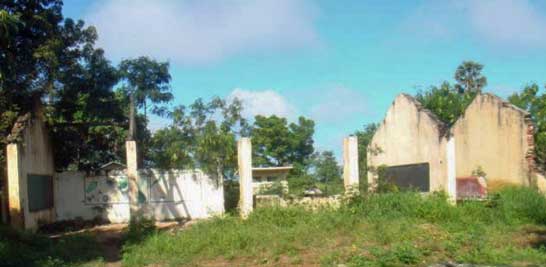The Parappankandal School was completed in 2011

The New Parappankandal School

The Students!
The Community: The school is located in the village of Parrapankandal, Mannar District. This district, one of five administrative districts in the Northern Province, is located in northwestern Sri Lanka. It covers 2,002 square kilometers, approximately 3% of the total land area of Sri Lanka. Geographically, the bulk of Mannar lies within the arid and dry zone. High temperatures and low rainfall characterize the climate. The monthly temperatures range between 26.5°C and 30.0°C, with highs normally recorded between May and August. Mannar receives nearly 60% of its rainfall during the northeast monsoon, which lasts from October through December. The land area is relatively flat and sits at low elevations. Across the region's gently undulating terrain, rainwater is stored in tanks and used for irrigation of arable land. Crop cultivation (primarily paddy), fisheries, and animal husbandry support most people in Mannar District. Employment opportunities in the district are highly seasonal, and there are no institutional facilities for tertiary education. The district is inhabited by members of various communities, though the Tamil-speaking community is the most prevalent.
The last thirty years of conflict in the region have resulted in the displacement of large segments of the area's population. War has destroyed the region's infrastructure, displacement has scattered former communities, and the jungle has swallowed previously populated areas.
The residents of Parappankandal are very poor due to the decades-long war. Displaced on multiple occasions, these villagers have lost their houses, their belongings, and many of their loved ones. There are no concrete structures in the village. The shelters consist of temporary tin sheet sheds built by the government or INGOs. The villagers are dependent on cultivation as their main source of income. Drinking water is obtained from dug wells, and the village is without an electricity supply. Presently, the government is involved in de-mining the village and rebuilding the infrastructure.
The last thirty years of conflict in the region have resulted in the displacement of large segments of the area's population. War has destroyed the region's infrastructure, displacement has scattered former communities, and the jungle has swallowed previously populated areas.
The residents of Parappankandal are very poor due to the decades-long war. Displaced on multiple occasions, these villagers have lost their houses, their belongings, and many of their loved ones. There are no concrete structures in the village. The shelters consist of temporary tin sheet sheds built by the government or INGOs. The villagers are dependent on cultivation as their main source of income. Drinking water is obtained from dug wells, and the village is without an electricity supply. Presently, the government is involved in de-mining the village and rebuilding the infrastructure.

The damaged existing school building
The Need: Presently, classes at this school are conducted in a single permanent building and a temporary hut built by the government. There are classes from grades one up to 11. Due to a lack of space, some classes are held outdoors. Because of the structural and crowding problems, some parents send their children to schools far away, while other parents keep their children at home to help with farm work.
Under the resettlement program, officials of the Government of Sri Lanka have asked Room to Read to support the community by providing safe learning spaces for the children there.
The Project: The new 2500-square-foot School Room, has five classrooms and a corridor. Each classroom is 400 square feet, and the corridor is 500 square feet. The new building has cement block walls, a cement floor, and a clay tile roof mounted on a timber frame.
Under the resettlement program, officials of the Government of Sri Lanka have asked Room to Read to support the community by providing safe learning spaces for the children there.
The Project: The new 2500-square-foot School Room, has five classrooms and a corridor. Each classroom is 400 square feet, and the corridor is 500 square feet. The new building has cement block walls, a cement floor, and a clay tile roof mounted on a timber frame.
